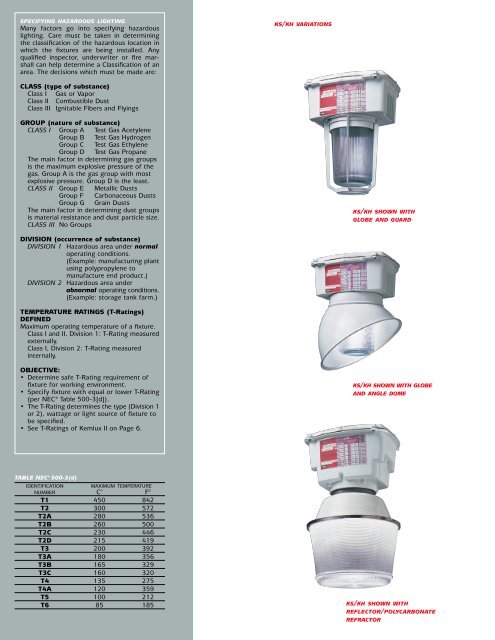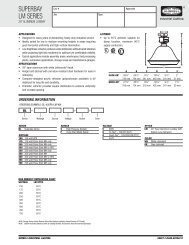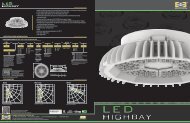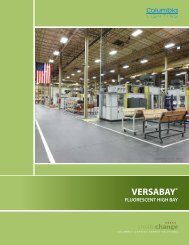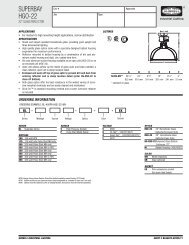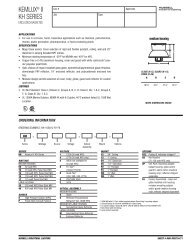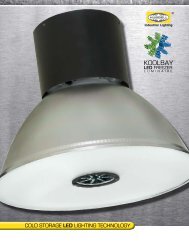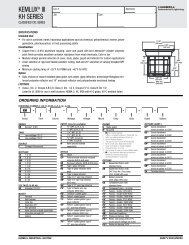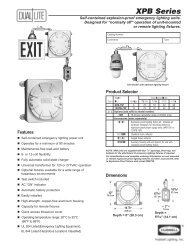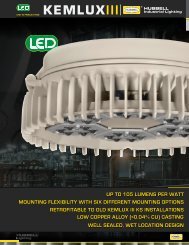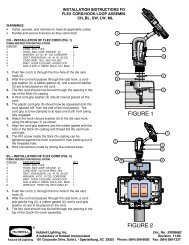Kemlux II Brochure - Hubbell Industrial Lighting
Kemlux II Brochure - Hubbell Industrial Lighting
Kemlux II Brochure - Hubbell Industrial Lighting
Create successful ePaper yourself
Turn your PDF publications into a flip-book with our unique Google optimized e-Paper software.
SPECIFYING HAZARDOUS LIGHTING<br />
Many factors go into specifying hazardous<br />
lighting. Care must be taken in determining<br />
the classification of the hazardous location in<br />
which the fixtures are being installed. Any<br />
qualified inspector, underwriter or fire marshall<br />
can help determine a Classification of an<br />
area. The decisions which must be made are:<br />
KS/KH VARIATIONS<br />
CLASS (type of substance)<br />
Class I Gas or Vapor<br />
Class <strong>II</strong> Combustible Dust<br />
Class <strong>II</strong>I Ignitable Fibers and Flyings<br />
GROUP (nature of substance)<br />
CLASS I Group A Test Gas Acetylene<br />
Group B Test Gas Hydrogen<br />
Group C Test Gas Ethylene<br />
Group D Test Gas Propane<br />
The main factor in determining gas groups<br />
is the maximum explosive pressure of the<br />
gas. Group A is the gas group with most<br />
explosive pressure. Group D is the least.<br />
CLASS <strong>II</strong> Group E Metallic Dusts<br />
Group F Carbonaceous Dusts<br />
Group G Grain Dusts<br />
The main factor in determining dust groups<br />
is material resistance and dust particle size.<br />
CLASS <strong>II</strong>I No Groups<br />
KS/KH SHOWN WITH<br />
GLOBE AND GUARD<br />
DIVISION (occurrence of substance)<br />
DIVISION 1 Hazardous area under normal<br />
operating conditions.<br />
(Example: manufacturing plant<br />
using polypropylene to<br />
manufacture end product.)<br />
DIVISION 2 Hazardous area under<br />
abnormal operating conditions.<br />
(Example: storage tank farm.)<br />
TEMPERATURE RATINGS (T-Ratings)<br />
DEFINED<br />
Maximum operating temperature of a fixture.<br />
Class I and <strong>II</strong>, Division 1: T-Rating measured<br />
externally.<br />
Class I, Division 2: T-Rating measured<br />
internally.<br />
OBJECTIVE:<br />
• Determine safe T-Rating requirement of<br />
fixture for working environment.<br />
• Specify fixture with equal or lower T-Rating<br />
(per NEC ® Table 500-3[d]).<br />
• The T-Rating determines the type (Division 1<br />
or 2), wattage or light source of fixture to<br />
be specified.<br />
• See T-Ratings of <strong>Kemlux</strong> <strong>II</strong> on Page 6.<br />
KS/KH SHOWN WITH GLOBE<br />
AND ANGLE DOME<br />
TABLE NEC ® 500-3(d)<br />
IDENTIFICATION<br />
MAXIMUM TEMPERATURE<br />
NUMBER C° F°<br />
T1 450 842<br />
T2 300 572<br />
T2A 280 536<br />
T2B 260 500<br />
T2C 230 446<br />
T2D 215 419<br />
T3 200 392<br />
T3A 180 356<br />
T3B 165 329<br />
T3C 160 320<br />
T4 135 275<br />
T4A 120 359<br />
T5 100 212<br />
T6 85 185<br />
KS/KH SHOWN WITH<br />
REFLECTOR/POLYCARBONATE<br />
REFRACTOR


